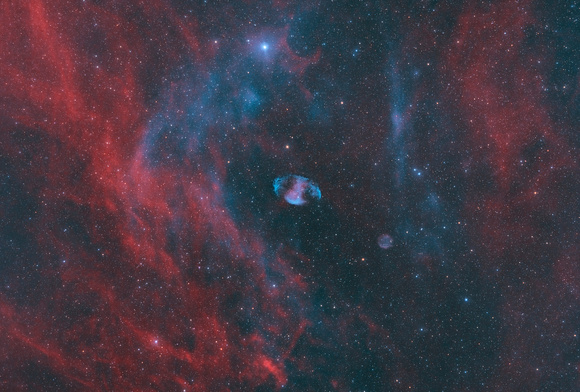Duo Ancient Planetary Nebula: MWP1 and ALV1 in Cygnus : HOO
MWP1 and ALV1 (Cygnus) in HOO (RGB stars) - August 2023
Televue 127is; AP Mach2 GTO
ASI6200MM, - Baader RGB & 6.5nm NB CMOS opt. filters
H, O – (58,54 x 450s, Bin 1, Gain 200)
R,G,B – (45,44,43 x 180s Bin 1, Gain 100)
Total integration time = 20.6 hrs – August 2023.
Both MWP1 (aka PK 080-10.1 or the Methuselah Nebula) and its even dimmer companion, ALV1 (aka PN G79.8-10.2) , represent ancient planetary nebula.
MWP1, at 15 light years across, is also the largest planetary nebula we know of and its size is attributed to the 150 thousand years or so that it has had to expand. Most planetary nebula don’t last that long and fade after a few 10s or thousands of years. MWP1 is 4500 ly away and since it is all but invisible with broadband detectors was only discovered in the 1990s. In fact, it was the weak but pulsating x-ray emissions from its progenitor star that first brought attention to it. This star is found slightly below the centre of the nebula and appears blue.
On a larger scale, MWP1 seems to be located in a large triangle of Oxygen signal, that seems to form an outer shell that is interacting with the inter-stellar media that forms a backdrop of Ha emissions.
I could only find very sparse information on ALV1. Its relatively large size, dimness and lack of crisp structure also hints at being ancient. It central white dwarf star is also blue, but much dimmer yet still visible in the image.
A lot of integration time was required to bring out any sort of details in the nebulae structures.


